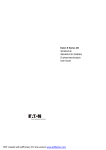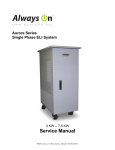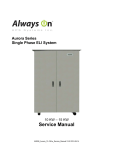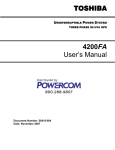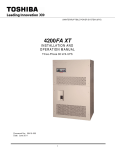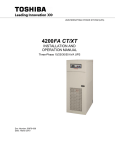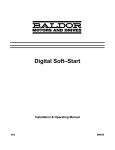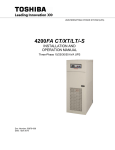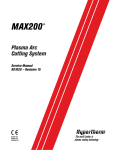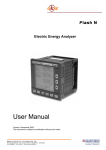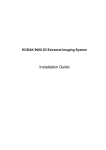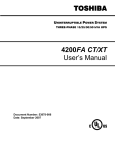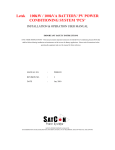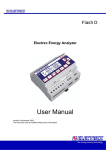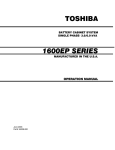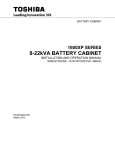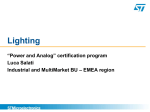Download TOSHIBA 4200 SERIES - ElectricalManuals.net
Transcript
TOSHIBA UNINTERRUPTIBLE POWER SYSTEM THREE PHASE- 75/100kVA UPS 4200 SERIES MANUFACTURED IN THE U.S.A. OPERATION MANUAL Part Number: 51751-001 Date: March, 2003 TOSHIBA 4200 SERIES THREE PHASE- 75/100 kVA UNINTERUPTIBLE POWER SYSTEM OPERATION MANUAL FOR MODELS U42B3F750C6CB U42B3F10KC6CB TOSHIBA INTERNATIONAL CORPORATION INDUSTRIAL DIVISION 13131 West Little York Rd., Houston, Texas 77041 1 TOSHIBA NOTE These Instructions are not intended to cover all of the details or variations in equipment, nor to provide for every possible contingency to be met in connection with installation, operation, or maintenance. This manual may change without notice. Contact your local Toshiba sales office to verify that this is the latest revision. Should further information be desired or should particular problems arise which are not covered sufficiently for the purchaser’s purposes, the matter should be referred to the local Toshiba sales office. The contents of this instruction manual shall not become a part of or modify any prior or existing equipment, commitment, or relationship. The sales contract contains the entire obligation of Toshiba International Corporation’s UPS Division. The warranty contained in the contract between the parties is the sole warranty of Toshiba International Corporation’s UPS Division, and any statements contained herein do not create new warranties or modify the existing warranty. Any Electrical or mechanical modifications to this equipment, without prior written consent of Toshiba International Corporation, will void all warranties and may void UL/CUL listing. Unauthorized modifications also can result in personal injury, death, or destruction of the equipment. UNINTERUPTIBLE POWER SUPPLY If additional information or technical assistance is required call Toshiba’s marketing department toll free at 1-800-231-1412, or write to: Toshiba International Corporation, 13131 W. Little York Rd., Houston, TX 77041-9990. Please complete the following information for your records; however, please keep this manual with the UPS equipment. Model Number: Serial Number: Date of Installation: Inspected By: 2 TOSHIBA GENERAL SAFETY INSTRUCTIONS Warnings in this manual appear in any of four ways: 1) Danger- The danger symbol is a lightning bolt mark enclosed in a triangle which precedes the 3/16” high letters spelling the word “DANGER”. The danger symbol is used to indicate imminently hazardous situations, locations, and conditions which, if not avoided, WILL result in death, serious injury, and/or severe property damage. DANGER 2) Warning- The warning symbol is an exclamation mark enclosed in a triangle which precedes the 3/16” high letters spelling the word “WARNING”. The warning symbol is used to indicate potentially hazardous situations and conditions which, if not avoided COULD result in serious injury or death. Severe property damage COULD also occur. WARNING 3) Caution- The caution symbol is an exclamation mark enclosed in a triangle which precedes the 3/16” high letters spelling the word “CAUTION”. The caution symbol is used to indicate potentially hazardous situations and conditions which, if not avoided COULD result in injury. Equipment damage may also occur. CAUTION 4) Attention warnings- The attention warning symbol is an exclamation mark enclosed in a triangle which precedes the 3/16” high letters spelling the word “ATTENTION”. The Attention warning symbol is used to indicate situations and conditions that COULD cause operator injury and/or equipment damage. ATTENTION Other warning symbols may appear along with the Danger and Caution symbol. The additional symbols are used to specify special hazards. These warnings describe particular areas where special care and/or procedures are required in order to prevent serious injury and possible death: 1) Electrical warnings- The electrical warning symbol is a lighting bolt mark enclosed in a triangle. The Electrical warning symbol is used to indicate high voltage locations and conditions that COULD cause serious injury or death if the proper precautions are not observed: 2) Explosion warnings- The explosion warning symbol is an explosion mark enclosed in a triangle. The Explosion warning symbol is used to indicate locations and conditions where molten, exploding parts that COULD cause serious injury or death if the proper precautions are not observed: 3 TOSHIBA TABLE OF CONTENTS GENERAL SAFETY INSTRUCTIONS ................................................................................. 3 TABLE OF CONTENTS ....................................................................................................... 4 IMPORTANT SAFETY INSTRUCTIONS ............................................................................. 6 1.0 Product Description .................................................................................................. 8 1.1 1.2 1.3 1.4 2.0 2.1 2.2 2.3 2.4 3.0 3.1 3.2 3.3 4.0 Theory of Operation.............................................................................................................................. 8 Application and use .............................................................................................................................. 8 Power Backup....................................................................................................................................... 8 Power Conditioning .............................................................................................................................. 8 Uncrating/Inspection/Storage/Disposal................................................................... 9 Uncrating the new UPS equipment: ..................................................................................................... 9 Inspection of the new UPS equipment ............................................................................................... 10 Storage of UPS equipment................................................................................................................. 10 Disposal .............................................................................................................................................. 10 Precautions...............................................................................................................11 Installation Precautions ...................................................................................................................... 11 Pre-start Precautions .......................................................................................................................... 12 Operating Precautions........................................................................................................................ 12 UPS Connections .................................................................................................... 13 4.1 Power Connections 75 and 100kVA................................................................................................... 13 4.1.1 Recommended Wire Size and Tightening Torque For UPS Input and Output Terminals ............ 14 4.1.2 Power Connection Cable Routing ................................................................................................. 15 4.2 Control Circuit and External Battery Interface Connections 75 and 100kVA ..................................... 16 4.2.1 Recommended Wire Size and Tightening Torque UPS Control and Battery Interface................. 16 4.3 Communication Interface.................................................................................................................... 17 4.3.1 Remote Contact (IBM AS/400) ...................................................................................................... 17 4.3.2 RS-232C ........................................................................................................................................ 18 4.3.3 UPS Shutdown (via RS-232C) ...................................................................................................... 18 5.0 5.1 6.0 Specifications .......................................................................................................... 19 4200 Series Specifications 75 and 100kVA @ Standard 208Vac Output.......................................... 19 Operating the UPS................................................................................................... 20 6.1 Operating the UPS ............................................................................................................................. 20 6.1.1 AC Input Mode (normal operation) ................................................................................................ 20 6.1.2 Circuit-bypass Mode...................................................................................................................... 20 6.1.3 Battery Backup Mode .................................................................................................................... 21 6.2 Battery Backup Time and Discharge Process.................................................................................... 21 6.3 Battery Low Voltage Tolerances......................................................................................................... 22 6.4 Battery Recharging ............................................................................................................................. 22 6.5 Front Panel Layout (All Units)............................................................................................................. 23 6.6 EPO (Emergency Power Off) Function .............................................................................................. 24 6.7 Audible Alarm Functions..................................................................................................................... 24 6.8 Light Emitting Diode (LED) Functions ................................................................................................ 25 6.8.1 Light Emitting Diode (LED) System Status.................................................................................... 25 6.9 Liquid Crystal Display (LCD) Functions.............................................................................................. 26 6.9.1 Line-1 System Messages .............................................................................................................. 26 6.9.2 Line-2 System Fault Messages ..................................................................................................... 26 6.9.3 Line-3 System Messages .............................................................................................................. 26 6.9.4 Line-4 System Messages .............................................................................................................. 27 6.10 Initial Battery Charge .......................................................................................................................... 28 6.11 Start-up Procedure ............................................................................................................................. 29 6.12 Shutdown Procedure .......................................................................................................................... 30 6.13 Keypad Overview................................................................................................................................ 31 6.14 Key Functions ..................................................................................................................................... 32 6.14.1 MONI ............................................................................................................................................. 32 6.14.2 IN ................................................................................................................................................... 32 4 TOSHIBA 6.14.3 OUT ............................................................................................................................................... 32 6.14.4 BATT Key ...................................................................................................................................... 33 6.14.5 MENU, F1, ENTER, UP, & DOWN Keys....................................................................................... 33 6.14.6 BATT TEST Key ............................................................................................................................ 33 6.14.7 BUZZ STOP Key ........................................................................................................................... 34 6.14.8 RESET Key.................................................................................................................................... 34 6.15 Menu Data Screens ............................................................................................................................ 35 6.15.1 Settings for Calendar and Clock.................................................................................................... 35 6.15.2 Adjusting Buzzer Volume .............................................................................................................. 35 6.15.3 Settings for Display Duration ......................................................................................................... 35 6.15.4 Run Switch Select ......................................................................................................................... 36 6.15.5 Serial Com Station Address .......................................................................................................... 36 6.15.6 Output Voltage Adjustment............................................................................................................ 37 6.15.7 Charge Mode Select...................................................................................................................... 37 6.15.8 Reset to Default Settings............................................................................................................... 38 6.16 Overload Operation ....................................................................................................................... 38-39 7.0 7.1 7.2 8.0 8.1 8.2 9.0 9.1 9.2 UPS Protection System .......................................................................................... 40 System Protection Features ............................................................................................................... 40 System Protection Functions.............................................................................................................. 40 Preventive and Scheduled Maintenance / Part Replacement .............................. 41 Preventive Maintenance ..................................................................................................................... 41 Parts Replacement ............................................................................................................................. 41 External Layouts / Dimensions / Shipping Weights ............................................. 42 External Dimensions 75 and 100kVA ................................................................................................. 42 Shipping Dimensions 75, and 100kVA .............................................................................................. 43 5 TOSHIBA IMPORTANT SAFETY INSTRUCTIONS manual contains important SAVE THESE INSTRUCTIONS This instructions for 4200 Series 75/ And 100kVA that should be followed during the installation, operation, and maintenance of the UPS Systems. Refer to the Battery System Manual for details on operating and maintaining the battery units for each system. UPS System’s output is not equipped with an over-current protection device, nor an output disconnect for the AC output; therefore, a circuit breaker should be provided, by the user, between the UPS output and the critical load input. This device should be rated as follows: Model 75kVA Rated Output 208/120Vac Device Rating 240V, 270A Model 100kVA Rated Output 208/120Vac Device Rating 240V, 350A The maximum ambient temperatures in which the Uninterruptible Power Systems should be operated in is 40°C. (25°C max. if battery cabinet is subject to same ambient) The nominal battery voltage for 75kVA is 240VDC; 100kVA is 324VDC A qualified Toshiba Representative who is knowledgeable of batteries and the required precautions should only perform servicing of the batteries. Keep unauthorized personnel away from batteries. Refer to the Battery System Manual, when scheduling maintenance or battery replacement. Misuse of this equipment could result in human injury and equipment damage. In no event will Toshiba Corporation be responsible or liable for either indirect or consequential damage or injury that may result from the use of this equipment. CAUTION CAUTION Do not dispose of the batteries in a fire. The batteries may explode. CAUTION Do not open or mutilate the batteries. Released electrolyte is harmful to the eyes and skin and could also be toxic. This unit contains sealed lead acid batteries. Lack of preventative maintenance could result in batteries exploding and emitting gasses and/or flame. An authorized, trained technician must perform annual preventative maintenance. WARNING Failure to replace a battery before it becomes exhausted may cause the case to crack, possibly releasing electrolytes from inside the battery, and resulting in secondary faults such as odor, smoke, and fire. WARNING 6 TOSHIBA WARNING Personnel knowledgeable of batteries and the required precautions should perform installation and servicing of batteries. Keep Unauthorized personnel away from the batteries. WARNING Proper maintenance to the battery system of this unit must be done by a qualified service technician, this is essential to the safety and reliability of your UPS system. Refer to service manual. A battery can present a risk of electrical shock and high short The following precautions should be observed circuit current. when working with batteries. Verify that the UPS is off and is disconnected from the power source. Remove watches, rings or other metal objects. Use tools with insulated handles to prevent inadvertent shorts. Wear rubber gloves and boots. Do not lay tools or metal parts on top of batteries. Determine if the battery is inadvertently grounded. If inadvertently grounded, remove source of ground. Contact with any part of a grounded battery can result in The likelihood of such shock will be reduced if such grounds are electrical shock. removed during installation and maintenance. Verify circuit polarities prior to making connections. Disconnect charging source and load prior to connecting or disconnecting terminals. VRLA batteries contain an explosive mixture of hydrogen gas. Do not smoke, or create a flame or spark in the immediate area of the batteries. This includes static electricity from the body. Do not attempt to open the batteries in order to add water or sample the specific gravity of the electrolyte. The batteries are valve regulated lead acid type and such servicing is not possible without damaging the battery. Use proper lifting means when moving batteries and wear all appropriate safety clothing and equipment. Do not dispose of lead acid batteries except through channels in accordance with local, state and federal regulations. DANGER 1) 2) 3) 4) 5) 6) 7) 8) 9) 10) 11) 12) INSTRUCTIONS IMPORTANTES CONCERNANT LA SÉCURITÉ ATTENTION Cette notice contient des instructions importantes concernant la sécurté Un battery puet présenter un risque de choc électrique, de brûlure par transfert d’ énergie. ATTENTION Por le replacement, utiliser le même nombre de batteries du modéle suivant. ATTENTION L’élimination des batteries est règlementèe. Consultar les codes locaux à cet effet. CONSERVER CES INSTRUCTIONS 7 TOSHIBA 1.0 Product Description 1.1 Theory of Operation An Uninterruptible Power Supply (UPS) is a system that is installed between the commercial power and the load equipment. The UPS provides steady AC output power during commercial power fluctuations and interruptions. During normal operation the UPS utilizes commercial AC power and removes high voltage spikes and transients caused by switching and faults on the main utility. The result of this process is maximum power conditioning and regulation. If the AC power supplied to the UPS drops below a specified voltage level, the unit's batteries automatically begin supplying power instead of receiving it. This insures that the loads connected to the UPS continue to receive power with no interruption. This power is provided for a long enough time so that the load can be shut down in an orderly fashion. This prevents loss of data and possible damage to both hardware and software. When AC input power becomes available again, operation returns to normal. The UPS batteries begin to recharge, so they will be ready for the next power interruption. 1.2 Application and use Toshiba's 4200 Series of on-line, Uninterruptible power systems (UPS) provide continuous computer grade AC power in a compact, efficient, high performance unit. The UPS assures safe, reliable operation of critical office equipment, ranging from personal computers to minicomputers to local area networks (LAN). All units feature an audible alarm that sounds if the battery voltage drops below standard during use. This is an additional aid to help in retaining the valuable office data banks, and all units allow for computer interfacing. 1.3 Power Backup During an electrical power failure the UPS unit's batteries automatically supply DC power to the inverter that supports the load equipment, without interruption. For example, when used to support a computer, the UPS’s back-up assures additional time to complete your activity and store data after a power failure occurs. 1.4 Power Conditioning While commercial power is present, the UPS supplies conditioned power to the load while maintaining its batteries in a charged condition. The UPS protects the connected load against the normal, everyday problems associated with heavy use of raw commercial power, including power sags, surges, signal interference, and spikes. This protection keeps power-line problems from reaching your load, where it can cause equipment to operate erratically, or damage software and hardware. 8 TOSHIBA 2.0 Uncrating/Inspection/Storage/Disposal 2.1 Uncrating the new UPS equipment: Upon receipt of the UPS, a careful inspection for shipping damage should be made. 1) Remove the screws that attach the shipping crate to the pallet; remove the crate and foam packing material. 2) Unbolt the rails from both the unit and the shipping pallet. Place the rails on the front of the pallet as shown in figure 2.2 and figure 2.3. Use the four 1/2x3" bolts used to secure the rails to the shipping pallet to attach the rails as shown to the front of the pallet. 3) Place the tie brackets as shown in figure 2.3 in the slots at the lower end of the ramps. SLOWLY roll the unit down the ramp. 9 TOSHIBA 2.2 Inspection of the new UPS equipment After Uncrating: 1) Check the unit for loose, broken, bent or other damaged parts. If damage has occurred during shipment, keep all original crating and packing materials for return to the shipping agent. The equipment warranty will not apply to units that are damaged during shipment. 2) Check to see that the rated capacity and the model number specified on the nameplate conform to the order specifications. 2.3 Storage of UPS equipment If the UPS equipment is to be subject to long or short-term storage, the following guidelines should be used. Avoid: 1) Storage in sites subject to extreme changes in temperature or high humidity. 2) Storage in sites subject to exposure of high levels of dust or metal particles. 3) Storage on inclined floor surfaces or in sites subject to excessive vibration. Before storing: 1) Charge the system's batteries. 2) Perform a complete system shutdown as described in section 6.12 of this manual. Storing: 1) Store within a temperature range of -20° to 40° C (-4° to 104° F). 2) For best results, store the UPS in the original shipping container and place on a wood or metal pallet. 3) The optimum storage temperature is 21° C (70° F). Higher ambient temperatures cause UPS batteries to need recharging more frequently. 4) If stored in an ambient temperature under 20° C (68° F); recharge the batteries every 9 months. 5) If stored in an ambient temperature of 20° to 30° C (68° to 86° F); recharge the batteries every 6 months. 6) If stored in an ambient temperature of 30° to 40° C (86° to 104° F); recharge the batteries every 3 months. 2.4 Disposal Please contact your state environmental agency for details on proper disposal of electrical components and packaging in your particular area. ATTENTION It is illegal to dump lead-acid batteries in landfills or dispose of improperly. Please help our Earth by contacting the environmental protection agencies in your area, the battery manufacturer, or call Toshiba toll-free at (800) 231-1412 for more information about recycling batteries. 10 TOSHIBA 3.0 Precautions Based on the 4200 Series UPS unit's external dimensions and the way the outer panels are removed; minimum amounts of unobstructed space around the unit is necessary for ventilation and maintenance access. Figure 3.1 shows the minimum clearances required for proper UPS site installation. 3.1 Installation Precautions 1) Do not install the UPS on an inclined surface, or areas that are subject to frequent vibrations or jolting. This could damage UPS circuits. 2) Do not allow liquids or foreign objects to get inside the UPS. 3) Allow at least 700 mm (28 in) on the front side and 500 mm (20 in) on the rear and sides of the UPS unit for air ventilation and maintenance access. 4) Do not install the UPS in a location that is subject to high humidity. Also, do not install the unit in areas that are exposed to direct sunlight, or contaminated areas subject to high levels of airborne dust, metal particles, or flammable gasses. 5) Verify the ventilation and air conditioning system at the site is capable of removing the heat generated by the UPS unit (see Section, 5.1 Specifications, "Environment"). Ambient temperature range for operating the UPS is 0° to 40°C (32° ~ 104°F); 25°C (77°F) is the recommended operating temperature for maximum battery life. 6) Avoid installation near sources of electrical noise. Always make sure that the unit's ground is intact to prevent electrical shock and help prevent electrical noise. 7) This UPS generates and radiates radiofrequency energy during operation. Although RFI noise filters are installed inside the unit there is no guarantee that the UPS will not influence some sensitive devices which are operating in near proximity. If such interference occurs, the UPS should either be installed farther away from the affected equipment and/or powered from a different source than the affected equipment. Figure 3.1 11 TOSHIBA 3.2 Pre-start Precautions Before connecting the UPS to a power source; move the MCCB switch (ON/OFF), on the side panel, to the OFF position and move the operation STOP/RUN key switch, on the front panel (See Section 9 for location), to the STOP position. 3.3 Operating Precautions 1) The UPS should not be powered up until the entire operation manual has been reviewed, and understood. 2) The input power source voltage must be within +10% to -15% of the rated input voltage. The input frequency must be within the rated input frequency range. Voltages and frequencies outside of the permissible range may cause internal protection devices to activate. 3) The UPS should not be used with a load whose rated input is greater than the rated UPS output. 4) Do not use the UPS to provide power to motors that require high starting current or a long starting time such as vacuum cleaners and machine tools. 5) Do not insert metal objects or combustible materials in the unit's ventilation slots. 6) Do not place, hang, or paste any objects on the top or on the exterior surfaces of the UPS. 12 TOSHIBA 4.0 UPS Connections 4.1 Power Connections 75 and 100kVA The following illustrates the wiring connections to the Input and Output Terminations points for the 75 and 100kVA UPS Models 4.1.1 H1 H2 H3 Input (N) L1 L2 L3 (N) GND 13 TOSHIBA Recommended Wire Size and Tightening Torque For UPS Input and Output Terminals Minimum Wire Size and Tightening Torque of UPS Input and Output Terminals 75 & 100kVA (USE MINIMUM 90° C INSULATED COPPER WIRING) 75kVA 100kVA Phase: (A) (B) (C) Tightening Tightening Input: (H1) (H2) (H3) AWG AWG AWG AWG Torque Torque (N) (H1)-(H3) (N) (in-lbs.) (H1)-(H3) (N) (in-lbs.) (L1)-(L3) (N) (L1)-(L3) (N) 208/120 300MCM 400MCM 325 375 350MCM 700MCM 325 375 All wire sizes are per the NEC 75kVA Output: (L1) (L2) (L3) (N) AWG (L1)-(L3) AWG (N) 100kVA Tightening Torque (in-lbs.) (L1)-(L3) (N) AWG (L1)-(L3) AWG (N) 208/120 300MCM 400MCM 325 375 350MCM Neutral Conductors are rated @ 1.73 or 200% of phase conductors, per NEC 700MCM 75kVA Tightening Torque (in-lbs.) (L1)-(L3) (N) 325 375 100kVA Input/Output (GND) AWG Tightening Torque AWG (G) 2 150 in-lbs. 2 14 Tightening Torque 150 in-lbs. TOSHIBA 4.1.2 Power Connection Cable Routing The following illustrates the proper cable routing that should be followed during the power connection process of the 75 and 100kVA. Top Conduit Entry Main Input Main MCCB Main Input (N) Output Ground Bottom Conduit Entry Note: 1) Input and Output conductors shall be installed in separate conduits, and installed in accordance with the latest edition of NEC and the authority having jurisdiction. 2) Battery conductors shall be installed in a separate conduit and be of low resistance type. 15 TOSHIBA 4.2 Control Circuit and External Battery Interface Connections 75 and 100kVA The following illustrates the wiring connections of the Control Circuits, and Battery Interface Circuits. 4.2.1 Recommended Wire Size and Tightening Torque UPS Control and Battery Interface Minimum Wire Size and Tightening Torque for UPS Control and Battery Interface Circuits USE MINIMUM 75° C COPPER WIRING TERMINAL 75kVA 100kVA (TERMINAL #) TIGHTENING TIGHTENING AWG AWG TORQUE TORQUE UPS CONTROL CIRCUITS 14-16 8 in-lbs. 14-16 8 in-lbs. (1-24)* BATTERY CONTROL 14-16 8 in-lbs. 14-16 8 in-lbs. CIRCUITS (3-6)* *Indicates Class 1 wiring methods is to be used. 16 TOSHIBA 4.3 Communication Interface 4.3.1 Remote Contact (IBM AS/400) The AS/400 interface is a standard feature and is available as dry switch contacts through a DB9 male connector located on the back side of the UPS (see Section 9 for DB9 connector location). The following schematic shows the contact state and pin assignment for each signal and the associated DB9 connector pin-out. 5 System Common DB9 Male Connector Outline (Facing Connector) 6 Bypass Active 1 2 3 4 5 7 Battery Voltage Low 6 8 UPS On-line 7 8 9 9 Battery Discharge 4 1 Fault Signal Detect 2 Notes: 1) Pin "switches" are shown in their inactive states (if battery voltage is low pin 7 will be connected to System Common). 2) Contacts are resistive loads rated at 30 Vdc, 0.1 amp. (125VAC 3A) 3) Pin number 3 is not used. 17 TOSHIBA 4.3.2 RS-232C The RS-232C serial communication interface is available through a DB9 female connector located on the backside of the UPS (see Section 9 for DB9 connector location). This interface allows control of the UPS from a personal computer running special Toshiba software. The computer and the UPS are connected through a serial RS-232C communication port. The available data from the UPS, via the RS-232C communication link, is shown below: Operating Conditions UPS Operating Status (Described as “yes or “no”) Fault Details (Described as “occurred” or “not occurred”) Input Voltage Output Voltage Output Current Battery Voltage Input Frequency Output Frequency Utility Power OK Low Battery Voltage Detected UPS in BYPASS Mode UPS in NORMAL Mode Input and Output Frequency Synchronized UPD FAULT Occurred DC Bus Over-Current DC Bus Over-Voltage DC Bus Under-Voltage Input Over-Current Overheat Overload Being Timed Overload (allowable time exceeded) Output Over-Voltage (during Normal Mode) Output Under-Voltage (during Normal Mode) The connector pin assignment and female connector outline are illustrated below. DB9 Female Connector Outline (facing connector) Pin 1 2 3 4 5 6 7 8 9 I/O Input Output Output Input Output Input Symbol Description This pin is not used RXD Receive Data TXD Transmit Data DTR Data Terminal Ready SG Signal Ground DSR Data Set Ready RTS Request To Send CTS Clear To Send This pin is not used 4.3.3 5 4 9 3 8 2 7 1 6 UPS Shutdown (via RS-232C) When the UPS is operating from its internal batteries, a 'shutdown' order can be sent to the UPS telling it to turn OFF after a user-specified amount of time. This function can allow you to stop discharging the UPS batteries after an orderly system shutdown has been completed. The UPS can be programmed to turn OFF up to 8 minutes after the 'shutdown' command is given. This command can be cancelled before the specified time has elapsed by following the directions listed on the RS232 screen. 18 TOSHIBA 5.0 Specifications 5.1 Input Battery Output 4200 Series Specifications 75 and 100kVA @ Standard 208Vac Output Model Number Rated Output Capacity External Dimensions Rated Voltage Voltage Variation Rated Frequency Number Phases / Wires * Power Factor Required Input KW Walk-in Function Inrush Current Current Limit * Harmonic Currents DC Nominal (Voltage Range) Float Charge (Regulation) Ripple Voltage **Rated Back-up Time Rated Charge Current Rated Voltage Rated Current Rated Power Factor Number Phases / Wires Voltage Regulation (phase-phase) Voltage Adjustment Range Phase Displacement Rated Frequency Frequency Regulation Frequency Synchronous Frequency Slew Rate Voltage Transients (Recovery time: 50 msec.) Inverter Overload Capacity Bypass Overload Capacity Crest Factor Neutral Line Conductor Harmonic Voltage Distortion Inrush Current protection U42B3F750C6CB 75kVA 0 U42B3F10KC6CB 100kVA 0 208V/120V +10% to –15% ; (-15% to –30%) **** 50/60 Hz 3 Phases ; 4 Wire + GND Greater than .98 when in inverter mode 75 100 From 20% to 100% over 5 seconds Less than 12 times rated current under synchronous operation 115% maximum Less than 3% THD 240VDC (210 to 276VDC) 324VDC (284 to 374VDC) 274VDC (±2%) 2.28V/cell 370VDC (±2%) 2.28V/cell 2% R.M.S. Refer to Battery System Manual 20.0 Amps 208 / 120 VAC 208.3 Amps 277.8 Amps .8 lagging 3-phase 4 Wire + GND ± 2% (0-100% balanced load); ± 3% (0-100% unbalanced load) ± 5V Manually from front key pad ± 2° (0-100% balanced load); ± 4° (unbalanced load) 50 / 60 Hz ± 0.1% in free running mode ± .5/1.0/1.5 Hz (± 1.0 Hz. std.) switch selectable by qualified technician 1 Hz/s to 3Hz/s ± 5% (100% load step change); ± 3% (loss or return of input voltage); ± 8% (transfer of bypass to inverter) 125% 30 sec ; 150% 5sec 1000% 10msec; 125% 10 min. 2.5 1.73 times line rating 1.5% max (linear load) Automatic transfer to bypass, then retransfer to inverter Environment Efficiency ac/dc/ac: 90% ; dc/ac: 92% Heat loss to be removed 22178 Btu/hr (5586kcal/hr) 27296 Btu/hr (6879 kcal/hr) Audible Noise 75db (A) at 1 meter from the units front display Operating Temperature 0°-40° C; optimal temperature is 25° C Operating Humidity Less than 90% RH (no condensation) Altitude *** Less than 1000 meters Items marked with an (*) are specified at rated conditions under balanced linear loads. (**) Battery backup time may vary depending on the operating conditions and ambient temperature at the installation site, and an initial charge time of 24 hrs is necessary to obtain proper battery performance level before the unit is placed in operation. (***) At 6600-ft (2000 m) above sea level, output capacity should be derated by 3%. (Consult Factory for higher elevations) (****) Prolonged operation at this level requires some deration of output capacity. 19 TOSHIBA 6.0 Operating the UPS 6.1 Operating the UPS 6.1.1 AC Input Mode (normal operation) The following illustration shows circuit power flow when the UPS is operating normally in the AC input mode. The UPS unit's rectifier, including a boost chopper circuit, converts AC input power to DC power. The boost chopper circuit maintains a constant voltage, with current limiting, for charging the batteries. It also supplies a DC voltage of the proper level to the inverter section. The inverter section generates a high quality sinewave output voltage. The unit's batteries are always maintained in a constantly charged state when the UPS are in the normal operation mode. Power flow in AC input mode for the 75 and 100 kVA models 6.1.2 Circuit-bypass Mode If the UPS unit is severely overloaded or develops an internal fault, power flow is automatically switched from the unit's main circuit to the units bypass circuit. Power flow through the bypass is shown in the following illustration. This changeover occurs automatically in less than 4 milliseconds in phase. The switching period is not long enough to cause interruptions to occur in most loads. If the power flow is transferred to the bypass circuit because of an overload, and that overload condition ends within a specified period of time, then the power flow will be "re-transferred" to the AC input mode (normal operation) automatically. If the power flow is transferred to the bypass circuit due to a fault condition, then the power flow must be transferred manually from the UPS's bypass circuit back to the inverter circuit after repairing the fault (see Section 6.11 "Start-up Procedure"). If the power flow is transferred to the bypass circuit due to an overload condition, then the power flow will automatically transfer from the UPS's bypass circuit back to the inverter circuit after removing the overload (see Section 6.16 "Overload Operation"). Power flow in circuit-bypass mode for 75 and 100 kVA models 20 TOSHIBA 6.1.3 Battery Backup Mode The following illustration shows power flow during the battery backup mode. When commercial ac power failures occur, the UPS's batteries instantly begin supplying DC voltage to the UPS's main inverter circuit. This circuit changes (inverts) the DC power into AC power. The AC power is available at the unit's output. This back-up process will continue until the UPS's battery voltage drops below a specific minimum level. When this occurs, the batteries will stop supplying power to the load. This minimum level is the shutdown voltage minimum (V min). The rated battery voltage chart on page 22 shows (V min). The battery backup time and discharge process is explained in Section 6.2. Power flow in battery backup mode for the 75 and 100 kVA models 6.2 Battery Backup Time and Discharge Process The UPS system, when used in conjunction with a Toshiba designed Battery System, is designed to provide several minutes of back-up time for the 75, 100 kVA models (Refer to the Battery System Manual for back-up times). These times are valid when the unit is operating under full load. When these models are operating at half load, the batteries can provide approximately 2 times the specified value. The exact length of these times will depend on the UPS model used, condition of the batteries, amount and type of load, temperature and other variables. Contact Toshiba when using other than Toshiba designed Battery Systems to determine proper compliance. Using other systems could void Warranty and or Safety Certifications. CAUTION 21 TOSHIBA The following illustration graphically shows the battery discharge process at full load conditions. 6.3 Battery Low Voltage Tolerances Excessive discharge will cause the UPS system's battery voltage to drop bellow tolerable levels. The chart shown below lists the voltage level at which each UPS unit's low-voltage alarm will sound, and also at what level the low-voltage condition will cause the unit to automatically shut down. 75kVA 240Vdc 228Vdc 210Vdc Nominal Voltage Alarm Voltage Shutdown Voltage min. 6.4 100kVA 324Vdc 308Vdc 283Vdc Battery Recharging The illustration below shows a graphical representation of the UPS battery recharge process after a full discharge. 22 TOSHIBA The recharge process usually consists of three periods. During the first period, the charging current is maintained at approximately 38.0 amperes. This current is the maximum value that can be used to charge the batteries (for minimal recharge time) while assuring safety and long battery life. In the second period, constant-voltage control starts and current gradually decreases as the batteries charge to their normal fully charged state. In the third period, a slight "trickle" current continues to flow into the batteries to keep them fully charged and "floating" at the normal DC Voltage level. A full recharge usually requires approximately 24 hours (90% recharge in 10 hours) after a complete discharge. The following chart shows the rated maximum and minimum battery voltages, and the charge current for each of the sizes while the unit is maintained in a 75°F ambient. Rated Battery Voltages 75kVA 100kVA Model 270.0 Vdc 370.0 Vdc V float 210.0 Vdc 283.0 Vdc V min 38.0 Amps 38.0 Amps I charge 6.5 Front Panel Layout (All Units) Refer to the following illustration for the entire UPS front panel operating procedures. 23 TOSHIBA 6.6 EPO (Emergency Power Off) Function These units are equipped with terminals for receiving an emergency power-off (EPO) "closed contact" switch command from two locations: (1) a remote location (see Section 4.3 Terminal Block Details) and (2) from a front panel mounted EPO switch (see Section 6.5 "Front Panel Layout). This safety feature enables quick shutdown of the UPS AC output and battery circuits. Usually the emergency power off switch is installed in a central location that is easily accessible to personnel concerned with the operation of the UPS unit and the equipment connected to it. The EPO function is initiated by pressing the switch to the closed "shutdown" position. The effect of using the EPO switch is the same whether the UPS unit is in the AC input mode (see Section 6.1.1), battery backup mode (see Section 6.1.3), or the circuit bypass mode (see Section 6.1.2). See 'EMERGENCY OFF' screen in Section 6.1.2 "Shutdown Procedure." The following figure shows the UPS condition after application of the EPO switch. Use the Start-up Procedure (see Section 6.11) for restarting the unit. 6.7 Audible Alarm Functions Audible alarms will sound when the UPS unit is in the battery backup mode, has a fault, has low battery voltage, or is in an overload condition. The following chart shows the audible alarm pattern duration for each condition. Time intervals are shown in seconds. The audible alarm can be stopped by pressing BUZZ STOP on the front panel keypad (see Section 6.5 "Front Panel Layout"). Condition Audible pattern UPS in Battery Backup Mode (Battery Voltage 100-90%) 7S UPS Low Battery (Battery Voltage < 90%) 1S 1S Overload .5 S .5 S .5 S Fault 24 .5 S 1S TOSHIBA 6.8 Light Emitting Diode (LED) Functions The following list describes the conditions necessary for each LED lamp to be "on". This green LED lamp is "on" when the UPS is not in an input over-voltage condition, input under-voltage condition, or power failure state. If there is an input power failure, this lamp is "off". If there is no power failure and the input voltage is in an over-voltage condition, the AC IN lamp will flicker on and off rapidly (0.4 sec "on" and 0.4 sec "off"). If there is no power failure and the input voltage is in an under-voltage condition, the AC IN lamp will be "off". This green LED lamp is "on" when the UPS unit's inverter is operating. This green LED lamp is "on" when the UPS is in the static bypass mode. This green LED lamp is "on" when the UPS is in the battery-discharge mode. If the battery is low during a battery discharge, the BATT lamp will flicker on and off slowly (1.2) sec "on" and 1.2 sec "off"). The BATT lamp will go "off" if the battery voltage reaches the shutdown level during the battery-discharge mode. This red LED lamp is "on" when the UPS is in a fault condition. 6.8.1 Light Emitting Diode (LED) System Status The following chart shows the UPS system status that can be determined by decoding the "on" and "off" condition of the LED lamps. It should be used in conjunction with the LCD display (see Section 6.9) and the audible alarms (see Section 6.7) for total system monitoring. LED ON/OFF STATUS LED Normal UPS Operation (UPS on-line, no abnormal conditions) AC IN INV BYP BATT FAULT Output Shutdown (After Emergency Power Off received (EPO)) ON ON OFF OFF OFF AC IN INV BYP BATT FAULT ON OFF ON OFF ON AC IN INV BYP BATT FAULT Battery Back-up; (Battery Voltage Low) AC IN INV BYP BATT FAULT OFF OFF OFF OFF OFF Fatal Communication Error (Display to Control Interface) Bypass operation; UPS Fault AC IN INV BYP BATT FAULT ON/OFF STATUS OFF ON OFF ON (Blinking) OFF 25 ALL ON OR FLICKERING RAPIDLY TOSHIBA 6.9 Liquid Crystal Display (LCD) Functions The liquid crystal display (LCD) screen is a 4-line by 20-character wide display. The LCD display contains information about the operation of the UPS. It should be used in conjunction with the LED display (see Section 6.8) and the audible alarms (see Section 6.7) for total system monitoring. The LCD displays certain information only on specific lines of the display. This information is determined by the UPS operating mode and conditions. These messages are shown in the following line message charts. 6.9.1 Line-1 System Messages Line-1 messages are based on the operating mode. The following chart shows all allowable Line-1 messages, which occur while starting up and while in main monitor (MONI) screen mode. LINE-1 MESSAGES Meaning Displayed when UPS is in the start-up condition - START UP or display board is resetting. Displayed when the UPS is in Bypass - BYPASS OPERATION Operation. Displayed when the inverter is running, and no - UPS ON-LINE Utility abnormal exists. Displayed during Utility abnormal; inverter is supplying power from batteries. (Unit shuts - BATTERY DISCHARGE down after V (min.) is reached. Displayed during power failure if V (min.) is reached, or an EPO is received, or after - OUTPUT SHUTDOWN completion of Start-Up Sequence of the Inverter and Bypass is not available. Displayed during input power failure. - BATTERY BACKUP Display Message 6.9.2 Line-2 System Fault Messages Line-2 fault messages are automatically displayed when a system fault is detected. Display Message DCUV DCOC DCUB DCOV EERR OH OL IVUV IVOV 6.9.3 LINE-2 MESSAGES Meaning DC Under-voltage DC Over-current DC Unbalanced DC Over-voltage Main EEPROM error Overheat (internal) Output Overload Inverter Under-voltage Inverter Over-voltage Line-3 System Messages Line–3 messages show load current information, and user selected instructions. 26 TOSHIBA 6.9.4 Line-4 System Messages Line-4 messages reflect the UPS operating conditions. Warning messages will be displayed when an abnormal operating condition occurs. The following chart shows the allowable Line-4 messages. Line-4 Messages Displayed Message PHEI I/O NOT SYNCHRONIZE * AUTOTRANSFER * * BATTERY LOW * * UPS OL: REDUCE LOAD * * DCOC * * DCOV * * DCUB * * UPS OL * * FUSE OPEN * * INOV * * INUV * * BATTOH *OR MCCB-B OPEN * UPS OK * * DISCHARGE CURR=###% * * TRANSFER INHIBITED * * EMERGENCY OFF * * UPS OUTPUT DISABLED * * FAULT(S) DETECTED * Meaning Displayed when input Phase rotation is not wired for clockwise rotation. Displayed when input and output frequencies are not synchronized. (abnormal) Displayed when auto-transfer to bypass is active (i.e. current limit reached). (abnormal) Displayed when battery voltage is low (abnormal) or the UPS batteries have failed self-diagnostic test. (abnormal) Displayed when UPS has tripped due to an overload condition. (abnormal) Displayed when the UPS has an internal failure. (abnormal) Displayed when the UPS has an internal DC bus over-voltage. (abnormal) Displayed when the UPS has an internal DC bus unbalance referenced to Neutral. (abnormal) Displayed when UPS has tripped due to an overload condition. (abnormal) Displayed when an internal transistor fuse opens. Displayed when inverter output over-voltage has occurred. (abnormal) Displayed when inverter output under-voltage has occurred. (abnormal) Displayed when the optional battery over-temp sensor has annunciated, or if the external battery disconnect is open. (Verify TB3-5,6) Displayed when none of the above abnormal conditions are present. (normal) Displayed when none of the above abnormal conditions are present and the UPS is in battery discharge mode. (normal backup) Displayed when key switch position is changed and frequency is not synchronized. (abnormal) Displayed when an emergency (EPO) signal is received. Displayed when UPS has normally shutdown. Displayed when a fault or faults have occurred. (abnormal) Note: 1) Line-4 will be blank when the BATT key is pressed during battery backup mode with normal battery voltage. 2) The # symbol signifies numerical values or other information supplied by the UPS. 27 TOSHIBA 6.10 Initial Battery Charge The UPS System's battery must be charged before it is used for the first time or when the unit has not been used (AC power source removed) for more than 10 days. Use the following procedure to recharge the UPS System's battery: 1) Switch on power at the UPS input distribution panel. 2) Move the UPS unit's MCCB1 power switch to "on" (see Section 9 for location). Note: The UPS units’ battery charging circuit is now activated. The AC IN lamp will be "on". The LCD screen (see Section 6.5 "Front Panel Layout") should display the following message: - UPS START UP > PLEASE WAIT 3) With the key switch in the STOP position, the AC IN and the BYP lamp will be "on" and the LCD screen should display the following message: - BYPASS OPERATION OUTPUT VOLTAGE=208V >CURRENT 100/100/100% (DATE) DAY (TIME) 4) Turn the Key Switch to “RUN” and the UPS automatically performs a controlled system battery test. (Note: The Automatic Battery Test is performed only when the software is enabled for this function. The standard default is set to disable.) (Allow 24 hours for the batteries to fully charge). When automatic battery test fails and the LOW BATTERY message is displayed use the following procedure: 1) Turn the key switch to STOP. 2) Allow 24 hours for the batteries to charge and then move the MCCB switch (see Section 9 for location) to "off". 3) Repeat Initial Battery Charge procedure. (A failure indicates battery replacement necessary). 28 TOSHIBA 6.11 Start-up Procedure The UPS batteries must be charged before the UPS is used for the first time or if the unit has not been used (ac power source removed) for more than 10 days (Refer to Section 6.10). If the batteries are charged then use the following start-up procedure: 1) Verify that all power switches are off, and that the "RUN / STOP Switch on the UPS is in the STOP position. 2) Switch on the power at the Customer Provided UPS input distribution panel. 3) Move the UPS unit's MCCB power switch(es) to "on" (see Section 9 for location). The AC IN lamp will be "on". The LCD screen (see Section 6.5 "Front Panel Layout") should display the following message: - UPS START UP - Note: Lines 2 & 3 are blank. > PLEASE WAIT With the key switch in the STOP position, both the AC IN and the BYP lamp will be "on" and the LCD screen should display the following message: - BYPASS OPERATION – OUTPUT VOLTAGE=207V >CURRENT 100/80/90% DATE (DAY) TIME Note: Actual numerical values may differ from these examples. The UPS units’ battery charging circuit is now activated. Move the STOP/RUN key switch to the RUN position. The unit's inverter will then start and the UPS will be in the normal operating mode. Both the AC IN and the INV lamp will be "on". The following system message is an example of the main MONI (monitor) screen for standard operation (see Section 6.15.1 "MONI Function"): - UPS ON-LINE OUTPUT VOLTAGE=208V >CURRENT 100/80/90% DATE (DAY) TIME If a fault occurs during start-up, the red FAULT lamp will be "on" and the LCD screen will display a FAULT(s) DETECTED at start-up message such as the following: UPS FAULT (BYPASS ON) (DESCRIPTION) PRESS DOWN TO DETAIL > ENTER FOR DETAILS Note: UPS will not start when this message is displayed. Refer to Section 6.9.2 "Line-2 System Fault Messages" for details. 29 TOSHIBA 6.12 Shutdown Procedure When turning off the UPS, the following shutdown procedure should be used: 1) Move the unit's STOP/RUN key switch, located on the front panel, to STOP. Operation of the UPS unit's inverter stops. Output power is now provided to the load through the unit's bypass circuit. While in this state of operation; if a power failure occurs in the commercial power source, then the UPS will lose power and power to the load device will be interrupted. The UPS unit's battery charging circuit and chopper circuit remains activated. DANGER Do not touch the UPS terminals even though the operation switch has been moved to the STOP position. The UPS may be supplying power through the bypass circuit. The green AC IN lamp is "on" and the green BYP lamp is "on". The LCD screen shows the following message: BYPASS OPERATION OUTPUT VOLTAGE=207V >CURRENT 100/100/100% DATE (DAY) TIME - Note: Actual numerical values may differ from these examples. Move the MCCB power switch(es) to the "off" position. Power is removed from the UPS and to any attached loads. All lamps are "off" and the LCD screen shows the following message as long as sufficient power remains to display it: - OUTPUT SHUT DOWN OUTPUT VOLTAGE= 0V CURRENT=LOW/LOW/LOW% When the emergency power off (EPO) switch, located on the front panel (or from a remote located EPO switch) is pushed, the MCCB is tripped and power is removed from the UPS and to any attached loads (see Section 6.6 "EPO Function"). All LED lamps are "off" and the LCD screen will display the following message: - OUTPUT SHUT DOWN OUTPUT VOLTAGE= 0V CURRENT=LOW/LOW/LOW% 30 TOSHIBA 6.13 Keypad Overview The following illustrates the 12-key data entry pad with each key functionally labeled (see Section 6.5 “Front Panel Layout”). MONI BATT F1 IN OUT BATT TEST BUZZ STOP MENU ENTER RESET MONI Press to display system-monitoring screens (see Section 6.14.1). BATT Press to display UPS battery conditions (see Section 6.14.4). F1 Press to change settings of various menus (see Section 6.14.5). IN Press to display UPS input conditions (see Section 6.14.2). OUT Press to display UPS output conditions (see section 6.14.3). BATT TEST Press to execute on-line battery test (see section 6.14.6). BUZZ STOP Press to stop the UPS unit’s audible alert buzzer (see section 6.14.7). MENU Press to display the main user-selection menu (see section 6.14.5). ENTER Press to confirm user-selected command or action (see section 6.14.5). RESET Press to reset UPS panel’s message-display area (see Section 6.14.8). Press to forward through display data values, or to forward through menus (see section 6.14.5). Press to reverse through display data values, or to reverse through menus (see section 6.14.5). 31 TOSHIBA 6.14 Key Functions 6.14.1 MONI After the UPS has been successfully started, the system will be in the normal 'AC input mode' of operation. The LCD screen will automatically display the main MONI (monitor) function. If the MONI key is pressed at this time the screen output will not change. The MONI function automatically monitors the entire UPS system. The LCD screen will automatically switch "off" after a period of keypad inactivity and switch "on" if any key is pressed. It will switch "on" automatically during battery discharge or if an abnormality develops in the system (see Section 6.15.3 "Settings for LCD Display Duration"). All system 'line' messages will be displayed from MONI mode when abnormal operating problems are detected. If AC input power is available and no abnormal operating conditions are present the following system message is displayed: - UPS ON-LINE OUTPUT VOLTAGE= 208V CURRENT=100/100/99% DATE (DAY) TIME Note: Actual numerical values may differ from these examples. If output current drops below 15%, display reads: OUTPUT CURRENT=LOW. If an AC input power failure occurs, and no abnormal operating conditions are present, the UPS switched to standard 'battery backup mode'. The following system message is displayed: - BATTERY DISCHARGE BATT. CAPACITY=99% CURRENT=100/100/99% DISCHARGE CURR.=100% Note: Discharge current display in line-4 will occur MONI function only. 6.14.2 IN When the IN key is pressed during normal 'AC input mode' of operation, the LCD screen displays details about the unit's input voltage. The following system message is displayed: - UPS ON-LINE INPUT Vab= 96% VOLTAGE Vbc= 96% Vca= 96% The system’s Bypass Input Voltages, Frequencies / Sync Mode, and Converter Current can be monitored by pressing the "DOWN/UP" keys. 6.14.3 OUT When the OUT key is pressed during normal 'AC input mode' of operation, the LCD screen displays details about the unit's output voltage, current, and frequency. The following system message is displayed: - UPS ON-LINE OUTPUT Ia =101% CURRENT Ib= 100% Ic= 100% Note: If output current drops below 15% display reads : CURR=LOW. The system’s Output Line Voltages (phase-neutral, and phase to phase), Frequencies / Sync Mode, Inverter Output Power, and Power factor can be monitored by pressing the "DOWN/UP" keys. 32 TOSHIBA 6.14.4 BATT Key When the BATT key is pressed during normal 'ac input mode' of operation, the LCD screen displays details about the unit's battery capacity. The following system message is displayed: - UPS ON-LINE BATTERY VOLTAGE=270V CHARGE CURR.=0% Note: Discharge current in Line-3 is 0% unless unit is in the battery mode. Note: Line-4 is left blank. If an ac input power failure occurs, and no abnormal operating conditions are present, the UPS switches to standard 'battery backup mode'. The following system message is displayed when the BATT key is pressed: - BATTERY DISCHARGE BATT. CAPACITY=100% DISCHARGE CURR.=76% Note: Line-4 is left blank. 6.14.5 MENU, F1, ENTER, UP, & DOWN Keys When the MENU key is pressed during normal 'ac input mode' of operation, a menu of user adjustable data screens are available. Press 'up' arrow key to scroll up through the available data screens. Press 'down' arrow key to scroll down through the available data screens. Pressing the F1 key changes to the adjustment screen for that menu item. Press 'up' arrow to move display to previously available item. Press 'down' arrow to move display to next available item. From the adjustment screen, if the MENU key is pressed any changes are discarded and the display returns to the regular menu screen with the previous data values shown. If the ENTER key is pressed from the adjustment screen, the changes are saved. After pressing ENTER, the display screen will return to the regular menu screen with the new data values shown (see Section 6.13 "Menu Data Screens"). 6.14.6 BATT TEST Key When the BATT TEST key is pressed during normal 'ac input mode' of operation, the LCD screen displays details about the unit's battery back-up capacity. The following system message is displayed: - BATTERY TEST BATT. CAPACITY=###% > F1+ENTER TO BEGIN Press the F1+ ENTER keys at the same time to begin the battery test and to display the following screen while batteries are tested: - BATTERY TEST BATTERY CAPACITY=###% ## MINS ## SECS > PLEASE WAIT 33 TOSHIBA When the battery test is completed, the previous operation will be resumed and the main system MONI screen will be displayed. If the battery test detects a low DC battery voltage, then the message screen will display: - UPS ON-LINE OUTPUT VOLTAGE=208V CURRENT=38/55/48% * LOW BATTERY * If the battery test passes then the following screen message will be displayed: - UPS ON-LINE OUTPUT VOLTAGE=208V CURRENT=38/55/48% * UPS "OK" * Note: Press the MONI key to return to the main monitoring menu. If the inverter is not operating when the BATT TEST key is press then the function will be inhibited and the following screen message will be displayed: - BATTERY TEST BATTERY CAPACITY=###% BATT. TEST INHIBITED NOTE: After start-up, the battery test function is inhibited for 20-min. (only one battery test can be done approximately every 20-min.). 6.14.7 BUZZ STOP Key The BUZZ STOP key has no effect on the LCD screen display. However if the UPS alarm buzzer is sounding it can be disabled by pressing this key. If the alarm buzzer is not sounding, pressing this key has no effect. 6.14.8 RESET Key The RESET key function is used to 'reset' the LCD display board software should a system lock-up occur. The reset does not reset the variables in the memory. Use of the RESET function is very important when a fatal communication error has occurred. Press and hold the RESET key for a period of at least five seconds to reset the display software. The 'display board' to 'main board' interface will begin a new communication sequence. If a communication response is not received by the 'display board' from the 'main board' within 15 seconds, a fatal time-out occurs and the following system message displays: - DISPLAY ERROR MAIN COMM. ERROR Note: If this error message persist contact Toshiba Service Center. PRESS & HOLD RESET KEY If the 'reset' function is successful then the display will begin from the 'start-up screen' and then change to the 'main monitor' screen. 34 TOSHIBA 6.15 Menu Data Screens 6.15.1 Settings for Calendar and Clock Press the MENU key to access the menu data screens and press the 'down' arrow key to scroll to the present date and time adjustment screen: CALENDER / CLOCK DATE (DAY) TIME >*F1: DATA SET MODE >∆/∇ PRV/NEXT SCREEN Press the F1 key to display the following active adjustment screen: CALENDER / CLOCK DATE (DAY) TIME > ∆/∇ : UP/DOWN >ENTER:NEXT DATA Press the "up/down" arrows to increment, or decrement the character(s) above the flashing cursor. Press the ENTER key to advance the cursor. 6.15.2 Adjusting Buzzer Volume Press the MENU key to access the menu data screens and press the 'down' arrow key to scroll to the present buzzer volume adjustment screen display: BUZZER VOLUME ADJUST <LOUD> MEDIUM SOFT >*F1: DATA SET MODE >∆/∇:PRV/NEXT SCREEN Press the F1 key to display the following active adjustment screen: BUZZER VOLUME ADJUST <LOUD> MEDIUM SOFT >∆/∇: CHANGE DATA >ENTER:ACCEPT CHANGE Press the 'up' or 'down' arrow key to move the marker between the three buzzer volume levels. Press ENTER key to confirm the change or press MENU key to discard any changes and return to the menu data screen. 6.15.3 Settings for Display Duration The LCD display is designed to automatically switch off after a user-designated period of inactivity. When setting this feature, press the MENU key to access the menu data screens and press the 'down' arrow key to scroll to the LCD-Idle Mode Select screen display: DISPLAY DURATION SET <3 MIN> 30 MIN >F1: DATA SET MODE >∆/∇:PRV/NEXT SCREEN Press the F1 key to display the LCD-Idle mode setting adjustment screen: 35 TOSHIBA DISPLAY DURATION SET <3 MIN> 30 MIN >∆/∇: CHANGE DATA >ENTER:ACCEPT CHANGE Press the 'up' or 'down' arrow key to move the marker between the two available idle mode times. Press the ENTER key to save the change or press the MENU key to exit to the main menu and discard the change. Note: If any of the following conditions occur, the LCD-Idle Mode will be inhibited and the LCD will remain on continuously: 1) The UPS has received an emergency-off command. 2) The UPS is in battery discharge mode. 3) A fault has been detected in the main unit. 4) The UPS is in an overload condition. 6.15.4 Run Switch Select Press the MENU key to access the menu data screens and press the 'down' arrow key to scroll to the run switch select setting screen display: RUN SWITCH SELECT <LOCAL> REMOTE >*F1: DATA SET MODE >∆/∇: PRV/NEXT SCREEN Press the F1 key to display the following active adjustment screen: RUN SWITCH SELECT <LOCAL> REMOTE >∆/∇: CHANGE DATA >ENTER:ACCEPT CHANGE Press the 'up' or 'down' arrow key to move the marker between the two "RUN SWITCH" selections Press the ENTER key to save the change or press the MENU key to exit to the main menu and discard the change. (Must have Remote S/U option.) 6.15.5 Serial Com Station Address Press the MENU key to access the menu data screens and press the 'down' arrow key to scroll to the run switch select setting screen display: SER COM STATION ADDR STATION ADDRESS: 31H >*F1: DATA SET MODE > ∆/∇: PRV/NEXT SCREEN Press the F1 key to display the following active adjustment screen: SER COM STATION ADDR STATION ADDRESS: 31H >∆/∇: CHANGE DATA >ENTER: ACCEPT CHANGE 36 TOSHIBA 6.15.6 Output Voltage Adjustment When the MENU key is pressed and held 3-4 seconds during normal 'ac input mode' of operation, the LCD screen displays the output voltage on the present output voltage adjust screen: OUTPUT VOLT. ADJUST Note: ### indicate an actual OUTPUT VOLTAGE.=###% numerical value. >F1:DATA SET MODE > ∆/∇ :PREV/NEXT SCREEN Press the F1 key to display the following active adjustment screen: OUTPUT VOLT. ADJUST REFERENCE ADJUST: ## > ∆/∇ :CHANGE DATA >ENTER: ACCEPT CHANGE The locations marked ## will show the numerical value of the allowable voltage adjustment parameter values. Press the 'up' and 'down' arrow keys to adjust the setting from between –5 to +5. This will cause the unit's output voltage to adjust to within +/- 2% of its nominal value. If the inverter is not running, and the output voltage cannot be adjusted; the following message will be displayed: OUTPUT VOLT. ADJUST ADJUSTMENT INHIBITED > ∆/∇ Note: Press MENU key to return to previous menu. TO SCROLL Pressing the F1 key will have no effect on this display screen 6.15.7 Charge Mode Select Press the MENU key to access the menu data screens and press the 'down' arrow key to scroll to the “Charge Mode Select” adjustment screen display: CHARGE MODE SELECT EQUAL CHARGE>OFF ON >F1:DATA SET MODE >∆/∇:PRV/NEXT SCREEN Press the F1 key to display the following active adjustment screen: CHARGE MODE SELECT EQUAL CHARGE>OFF ON >∆/∇:CHANGE DATA >ENTER:ACCEPT CHANGE Note: Please consult the factory when utilizing this option. DAMAGE to the systems battery will occur if this is used improperly. 37 TOSHIBA 6.15.8 Reset to Default Settings Press the MENU key to access the menu data screens and press the 'down' arrow key to scroll to the original factory 'default settings' adjustment screen display: MENU DATA RESET DATA INITIALIZATION >F1: TO ACCESS RESET >∆/∇:PRV/NEXT SCREEN Press the F1 key to display the following active adjustment screen: MENU DATA RESET DATA INITIALIZATION > MENU: NO DATA RESET >ENTER: ACCEPT CHANGE When the ENTER key is pressed the following factory defaults are reset: 1) reset the voltage-reference setting to +0 2) reset the buzzer volume to 'loud' 3) reset the serial station address to 31h 4) reset the idle mode to 3 minutes Press the MENU key to abandon the operation and return to the menu data screen. 6.16 Overload Operation When the UPS is operating and an overload condition is first detected, the following “overload warning” screen is displayed. - UPS ON-LINE OUTPUT VOLTAGE= ###V OUTPUT CURRENT= ###% * UPS OL: REDUCE LOAD * Note: ### indicates an actual numerical value. After a period of time, if the overload is still not reduced and the STOP/RUN key switch is in the RUN position, the UPS will automatically transfer to bypass. If the overload condition is still present, the following screen will be displayed: - BYPASS OPERATION OUTPUT VOLTAGE=208 CURRENT= 114/116/114% * UPS OL: REDUCE LOAD * If the STOP/RUN key switch is in the STOP position; the UPS is in the bypass mode and, if the overload condition is still present, the following screen will be displayed: - BYPASS OPERATION OUTPUT VOLTAGE=208 CURRENT= 114/116/114% * UPS OL: REDUCE LOAD * After the load is reduced, if the STOP/RUN key switch is in the RUN position, the UPS will automatically return to 'inverter' operation after a period of time. During this wait, the following screen will be displayed: 38 TOSHIBA - BYPASS OPERATION OUTPUT VOLTAGE=208V CURRENT= 100/100/100 >PLEASE WAIT Or if the UPS is waiting and the RUN/STOP key switch is switched to the STOP position while the UPS is waiting, the following screen will be displayed: - BYPASS OPERATION OUTPUT VOLTAGE=208V CURRENT= 100/100/100 >PLEASE WAIT If the RUN/STOP key switch remains in the STOP position when the UPS's 'wait' period is complete, then the following screen will be displayed: - BYPASS OPERATION OUTPUT VOLATAGE=###V CURRENT=100\100\100% DATE (DAY) TIME If the RUN/STOP key switch remains in the RUN position when the UPS's 'wait' period is complete, then the following screen will be displayed: - UPS ON-LINE OUTPUT VOLTAGE= 208V CURRENT=100/100/99% DATE (DAY) TIME 39 TOSHIBA 7.0 UPS Protection System 7.1 7.2 Protection Item LCD Message Cause Operation Mode after Fault Audible Alarm Visible Alarm Relay Contact Alarm Auto-Retransfer System Protection Features The preceding one-line schematic illustrates the electrical locations of the protection devices on the 75, and 100kVA UPS models. System Protection Functions The following charts shows the built-in UPS’s fault protection functions on the 75 and 100kVA models. Built-in UPS Fault Protection Functions Inverter Overvoltage (IVOV) Inverter Undervoltage (IVUV) UPS Overload INVERTER INVERTER OVERVOLTAGE UNDERVOLTAGE Control Malfunction; Feedback Error OUTPUT OVERLOAD Overload or short circuit at the load. Inverter Overload: Transfer to bypass; Inverter stopped. Bypass Operation; Chopper and Inverter Stopped Bypass Overload: Inverter, Chopper, and Bypass stopped. Yes: See Section 6.7 Audible Alarm Functions Inverter OL: No Fault Lamp Red Fault Lamp “on” Bypass OL: Fault Lamp “on” Inverter OL: Bypass Relay closed Fault Relay closed; Bypass Relay closed Bypass OL: Bypass Relay open and Fault relay closed Inverter OL: Yes, if bypass ok No Bypass OL: No Protection Item Low Battery Voltage (level-1) Low Battery Voltage (level-2) Inverter Output Current Limit LCD Message Line-4 will read “BATTERY LOW” DC UNDERVOLTAGE OUTPUT OVERLOAD Cause Battery Discharge Battery Shutdown Level reached Load Inrush current Battery Discharge Shutdown: No Output Operation Mode after Fault Audible Alarm Visible Alarm Relay Contact Alarm Auto-Retransfer If Bypass ok, transfer to bypass; if not, current-limit mode Yes: See Section 6.7 Audible Alarm Functions NO Battery Lamp Flickers Low Battery Relay closed NO Bypass Relay closed No Yes, if bypass ok Protection Item Memory error (EERR) Internal overheat (OH) DC circuit overvoltage (DCOV) DC circuit overcurrent (DCOC) LCD Message Cause Operation Mode after Fault Audible Alarm Visible Alarm Relay Contact Alarm Auto-Retransfer MAIN EEPROM ERROR Control board chip error OVERHEAT; INTERNAL Fan failure; high ambient DC OVERVOLTAGE Chopper malfunction DC OVERCURRENT Inverter / chopper fault Start is inhibited Bypass operation; chopper and inverter are stopped Yes; continuous buzzer RED fault lamp “ON” Fault relay closed; bypass relay closed NO 40 TOSHIBA 8.0 Preventive and Scheduled Maintenance / Part Replacement 8.1 Preventive Maintenance Toshiba's 4200 Series of Uninterruptible Power Systems have been designed to provide years of trouble-free operation requiring a minimum of preventive maintenance. The best preventive measure that the UPS user can take is to keep the area around the unit, particularly the air inlet vents, clean and free of moisture and dust accumulations. If the atmosphere of the installation site is very dusty, use a vacuum cleaner to periodically remove dust accumulations from the system. Schedule authorized Toshiba service centers to perform internal parts inspections annually. CAUTION Before performing any maintenance the technician should be familiar with and follow the important safety instructions located on pages 3, 6 and 7. WARNING Proper maintenance of the battery system of this unit by a qualified service technician is essential to the safety and reliability of your UPS system. Refer to service manual. 8.2 Parts Replacement The following list shows intervals for periodic maintenance and replacement of certain UPS parts. 1) Batteries: VRLA batteries are maintenance free with respect to electrolyte only. The charging voltage, temperature, performance and connection resistance must be monitored periodically. Necessary corrective actions must be made in order to assure safe reliable power is supplied by the UPS. The aforementioned items affect the life of batteries, so replacement should be once every 3 to 5 years as a minimum. All of the batteries must be replaced at the same time. Quarterly Maintenance A. Visual Checks 1) Leakage 2) Corrosion on positive terminal B. Check battery temperature at the negative terminal C. Measure and record the system float charging voltage. D. Measure and record the individual unit’s float charging voltage. Semi-Annual maintenance A. Repeat the quarterly checks. B. Perform a 10-second high rate (e.g. 100 amp) load test on the individual batteries. C. Optionally test for the purpose of trending the battery over time. D. Re-torque all inter-battery connecting hardware (if applicable). E. Perform inter-battery connector resistance checks. 2) Aluminum electrolytic capacitors: Replace once every 5 years. 3) Fuses: Replace once every 7 years (see output fuse rating chart below). 4) Cooling fan: Replace once every 3 years. 41 32.308 (820mm) Optional Remote Eye II RS232-C Female Connector Remote Contacts IBM AS – 400 Male Connector 50.233 (1275mm) Front Panel (Section 6.5) EPO Switch (Section 6.6) Stop/Run Key Switch Battery Connector Access Panel FRONT 9.1 UPS Input MCCB SIDE TOSHIBA 9.0 External Layouts / Dimensions / Shipping Weights External Dimensions 75 and 100kVA 62.797 (1595mm) 42 TOSHIBA 9.2 Shipping Dimensions 75, and 100kVA Shipping Dimensions Width- Inches (cm) Depth- Inches (cm) Height- Inches (cm) Model U42B3F10KC6CB U42B3F750C6CB 75Kva 64.0 (162.6) 42.5 (108.0) 72.438 (184.0) 100kVA 64.0 (162.6) 42.5 (108.0) 72.438 (184.0) Shipping Weights 2600 Pounds 1180 Kilograms 2600 Pounds 1180 Kilograms 43 TOSHIBA TOSHIBA TOSHIBA INTERNATIONAL CORPORATION INDUSTRIAL DIVISION 13131 West Little York Road, Houston, Texas 77041 Tel: (713) 466-0277 Fax: (713) 466-8773 Printed in the U.S.A. 44













































